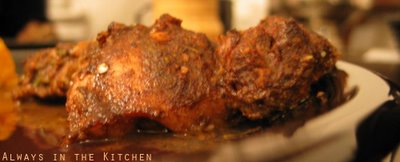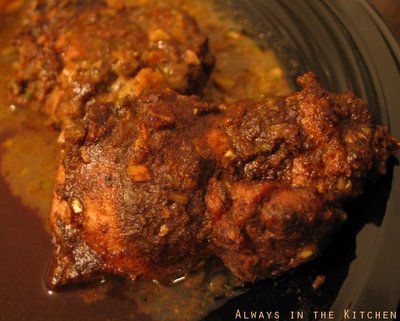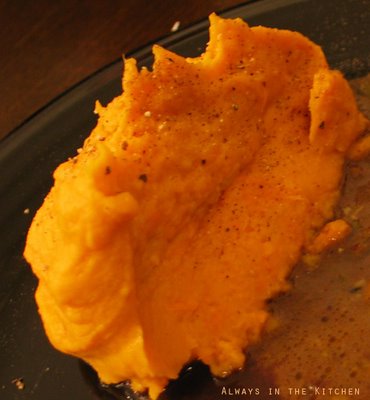 I should really let Palle write most of this entry, as it features his signature dish - a five star, five-alarm, tangy, fierce, and delicious jerk chicken. He makes the sauce from scratch - no pre-mixed seasonings or ready-pour fixings. It's just the man, the knife, and the blender and ingredients such as fresh limes, green onions, a boatload of allspice, and the all-important habanero peppers. He has been perfecting the dish for a while - trying it out on willing, yet oh-so-unsuspecting friends, tweaking the amounts of vinegar and ginger root, and coming to the understanding that the end product is irretrievably linked to the quality (and heat) of the peppers.
I should really let Palle write most of this entry, as it features his signature dish - a five star, five-alarm, tangy, fierce, and delicious jerk chicken. He makes the sauce from scratch - no pre-mixed seasonings or ready-pour fixings. It's just the man, the knife, and the blender and ingredients such as fresh limes, green onions, a boatload of allspice, and the all-important habanero peppers. He has been perfecting the dish for a while - trying it out on willing, yet oh-so-unsuspecting friends, tweaking the amounts of vinegar and ginger root, and coming to the understanding that the end product is irretrievably linked to the quality (and heat) of the peppers.I know that there are other things that one can "jerk" in the kitchen. Pork is quite popular down in the islands, and I suspect that a pork tenderloin baked in jerk sauce would be a real winner. Goat and lamb are also obvious choices - lamb being a little bit easier to source in my neighbourhood. Somehow, to this point, we have only managed to jerk chicken. In its defence, it is an outstanding combination - very much a classic dish.
It is a funny thing - a twitch, if you will - where it is virtually impossible for me to throw out leftover sauces. I scrape them into little plastic containers and stack them in the fridge for future use. Way back when I checked out Food Ninja's Jamaican Beef Patties, the sauce that I bumped mine up with was leftover jerk sauce that had been carefully hoarded against such an eventual need. I've also used leftover jerk sauce variously to add kick to bean dishes and casseroles and, quite memorably, as a pasta sauce. The pasta sauce worked so well, in fact, with only a little cream added to mitigate the heat, that tonight's leftovers will likely meet the same fate later this week. This time, however, there is a little chicken left over, too, which will make for quite a splendid re-working. All I really need to do is pick a pasta shape.
I'm surprised that we haven't used pasta as a side dish for jerk before, actually. We tend to rely heavily on a rotation of side dishes that might include several of: rice, cuban-style black beans (or replace both of those with Jamaican Style Rice & Beans), cole slaw, ceviche, and yams.

I have never had a bad instinct, when it comes to yams - well, those yams which are actually orange-fleshed sweet-potatoes, that is. I've been happy to eat them prepared pretty much any way they are presented to me, but it is only recently that I have added them to my repertoire with any real frequency. They were predominantly a holiday item at our table, baked and served with brown sugar and black pepper, and I have always been happy to eat them.
A culinary epiphany on Christmas day a few years ago led me to the creation of a holiday yam dish that was quite fresh and different from those that I had eaten before: I baked the peeled, cubed yams in mixed-citrus juice with whole spices - cinnamon, star anise, cloves, and allspice. They were tasty, and a pleasant change from the more sugary ones I was accustomed too. They became a Christmas tradition for us.
Over the last few years, I have ventured out more and more as I seek to find ways to make my meals not only healthier, but more delicious than ever before. I started adding yams to soups and curries, and was quite pleased with the results. I started sprinkling baked yam halves with ground cumin, salt and black pepper instead of sugar or butter, and this became a low-fuss favourite. Last year began my fascination with oven-baked yam fries, which has intensified now that I'm eating less white potatoes than I used to. It is amazing, what a little cumin seed and chili powder can do for a simple baked yam.
Today, I had another aberrant thought. Last week, while attending a gala dinner at a museum, I was served a tasty little tapas dish of fig-stuffed pork tenderloin over maple yam puree. As a still somewhat new yam enthusiast, I was delighted at the idea. The pork was tender and juicy, and nicely accented by the figs. The yam puree, however, was not up to snuff. It was grainy and fibrous, and leaked water into the bottom of the plate. The strong maple flavour sharpened the sweetness of a vegetable that does not need help in the sweetness department. It was, all in all, a disappointment.
So, since Palle was making jerk chicken for dinner, and since some sort of yam is a favourite accompaniment to jerk chicken, I set about re-inventing the yam puree. Nothing sweet was to be added, I told myself, and something has to be done about the texture.
I peeled and diced the yams and set them to steam and become soft enough to mash. A little chopped garlic sauteed in a tiny amount of butter was prepared on the side and topped liberally with ground cumin and left to infuse while the roots finished cooking - which didn't take long. I drained the tender cubes of yam and scraped the garlicky, cuminy butter into them, and set about vigorously mashing. Despite having chopped up the yam in its raw state, there were still disconcerting fibers. I finished the flavouring with a couple of tablespoons of coconut cream powder, and added just a little water to the pot. Still a bit grainy, still leaking a bit of water. I stared at the immersion blender for a moment, shrugged off the possibility that it would completely destroy the dish by rupturing too many starch molecues, and put it in motion. Immediately, the graininess disappeared and the liquid integrated into a smooth, velvety, luscious puree. I had found the answer. I only wish I had made more.
 Guess what we're having next time there's a jerk in our kitchen?
Guess what we're having next time there's a jerk in our kitchen?









